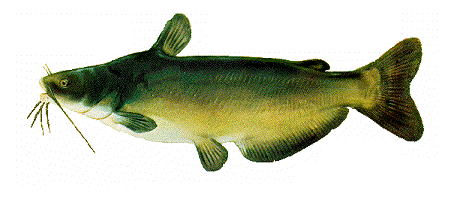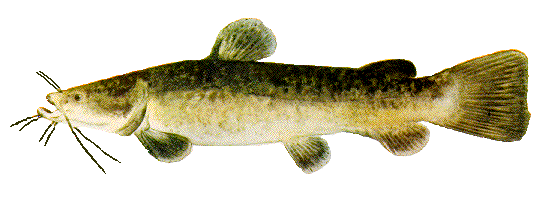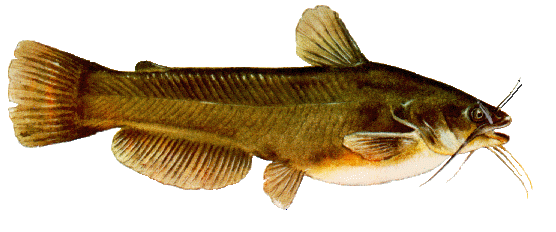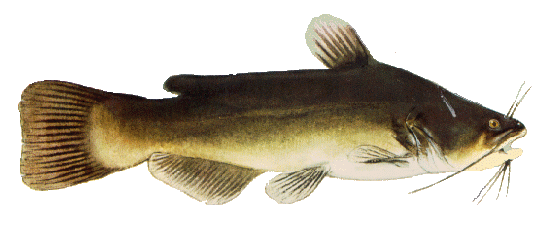
CHANNEL
BLUE
FLATHEAD
YELLOW
BULLHEAD
BLACK
BULLHEAD

Description
Ictalurus is Greek, and punctatus is Latin, meaning "fish cat" and "spotted", respectively. Channel catfish are easily distinguished from all others, except blue catfish, by their deeply forked tail fin. Unlike flathead catfish the upper jaw projects beyond the lower jaw. Coloration is olive-brown to slate blue on the back and sides, shading to silvery-white on the belly. Typically, numerous small, black spots are present, but may be obscured in large adults. The anal fin has 24-29 soft rays, as opposed to blue catfish, which always have 30 or more rays in the anal fin.
Biology
Channel catfish are most abundant in large streams with low or moderate current. They spawn in late spring or early summer when water temperatures reach 75°F. Males select nest sites which are normally dark secluded areas such as cavities in drift piles, logs, undercut banks, rocks, cans, etc. A golden-yellow gelatinous egg mass is deposited in the bottom of the nest. Males guard the nest, and may actually eat some of the eggs if they are disturbed. The eggs, if not devoured, typically hatch in about a week. Fry remain in the nest, under the guardianship of the male, for about another week. In clear water young fish appear to be much more susceptible to predation and survival during the first year of life is much lower. Channel catfish less than 4 inches in length feed primarily on small insects. Adults are largely omnivorous, feeding on insects, mollusks, crustaceans, fish, and even some plant material. Sexual maturity is reached in two or three years in captivity whereas data from natural populations indicates channel catfish in Texas reach sexual maturity in 3-6 years. Most are mature by the time they reach 12 inches in length.
Distribution
Channel catfish are native to North America east of the Rockies from southern Canada, south into northeastern Mexico, and east of the Appalachians, with the exception of much of the coastal plain north of Florida. The species has been widely introduced in other areas as far west as California. Today channel catfish range throughout Texas; however, it is believed that the species was not native to the upper Rio Grande and Pecos basins.
BACK TO
INDEX
Back to PhartAttack -on-
Phishing

Description
Ictalurus is Greek, meaning "fish cat", and furcatus is Latin, meaning "forked", a reference to the species forked tail fin. Blue catfish have a forked tail, and are sometimes very similar to channel catfish. However, only the Rio Grande population has dark spots on the back and sides. The number of rays in the anal fin is typically 30-35, and coloration is usually slate blue on the back, shading to white on the belly.
Biology
Blue catfish are primarily a large-river fish, occurring in main channels, tributaries, and impoundments of major river systems. They may tend to move upstream in the summer in search of cooler temperatures and downstream in the winter in order to find warmer water. Their spawning behavior appears to be similar to that of channel catfish. However, most blue catfish are not sexual mature until they reach about 24 inches in length. Like channel catfish, the blue catfish diet is quite varied, but it tends to eat fish earlier in life. Although invertebrates still comprise the major portion of the diet, blue catfish as small as four inches in length have been known to consume fish. Individuals larger than eight inches eat fish and large invertebrates. Blue catfish commonly attain weights of 20-40 pounds, and may reach weights well in excess of 100 pounds. It is reported that fish exceeding 350 pounds were landed from the Mississippi River during the late 1800's. A popular way to fish for BLUE CATFISH is with a balloon line using my "CONTROLLED DEPTH" method.
Distribution
Blue catfish are native to major rivers of the Ohio, Missouri, and Mississippi River basins. The range also extends south through Texas, Mexico, and into northern Guatemala. In Texas it is absent from the northwestern portions of the state including the Panhandle, but present elsewhere in larger rivers.
BACK TO
INDEX
Back to PhartAttack -on-
Phishing

Description
Pylodictis is Greek, meaning, "mud fish", and olivaris is Latin for "olive-colored". Flathead catfish are typically pale yellow (hence the name "yellow cat") to light brown on the back and sides, and highly mottled with black and/or brown. The belly is usually pale yellow or cream colored. The head is broadly flattened, with a projecting lower jaw. The tail fin is only slightly notched, not deeply forked, as is the case with blue and channel catfish. Young fish may be very dark, almost black in appearance
Biology
In Texas flathead catfish may spawn from late May through August. Males construct nests by excavating a shallow depression in a natural cavity (such as hollow logs, caves, or crevices), or near a large object. Females are encouraged to lay their eggs in the nest by males. Over 100,000 eggs may be found in a golden-yellow egg mass which is guarded viciously by the male. Young generally hatch in four to six days. They may school together for several days near the nest, but soon disperse and seek shelter under rocks or brush. Fingerlings feed on insect larvae, juveniles feed on small fish and crayfish, while adults feed almost exclusively on fish. Adults are usually solitary, each staking out a favorite spot, typically in deeper water or under cover, during the day. At night they may move into riffles and shallow areas to feed.
Distribution
The native range includes a broad area west of the Appalachian Mountains encompassing large rivers of the Mississippi, Missouri, and Ohio basins. The range extends as far north as North Dakota, as far west as New Mexico and south to the Gulf including eastern Mexico. Flathead catfish occur statewide in Texas.
Angler Importance
The flathead catfish is the second largest freshwater sports fish in Texas, being out muscled only by the blue catfish. Where mature populations exist, 50 pounders are not unusual. Typically, Trotliners have landed specimens in excess of 110 pounds. "Catfish" is the second most preferred group of fish by licensed Texas anglers, and Flatheads rank second behind channel catfish. Rod and reel anglers may have the greatest success with flathead catfish just below reservoir dams.
BACK TO
INDEX
Back to PhartAttack -on-
Phishing

Description
Ameiurus means "primitive or curtailed" in reference to the notch in the distal end of the caudal fin, and natalis is Latin for "having large buttocks". Yellow bullheads are typically light yellow to olive-green on the back, often somewhat mottled. The belly is yellowish to white. The tail is not notched, and may be slightly rounded. Chin barbels are white. The anal fin has 23-27 rays.
Biology
During late spring or early summer yellow bullheads excavate nests in mud bottoms and spawn. Both parents guard the nest, which may contain 2,000 to 12,000 eggs. In four to six days eggs hatch and fry begin to school in compact balls which are guarded by adults until individuals reach about one inch in length. Like black bullheads the yellow bullhead is omnivorous feeding on a variety of plant and animal material, both live and dead. Immature aquatic insects and crustaceans often comprise a considerable proportion of the diet. Although yellow bullheads rarely achieve edible size, some individuals may exceed four pounds.
Distribution
Yellow bullheads range throughout the central and eastern U.S. from central Texas north into North Dakota and east through the Great Lakes region to the coast. The species is found throughout Texas with the exclusion of the Trans-Pecos and Panhandle drainages.
Angler Importance
Like black bullheads, yellow bullheads are not generally considered an important gamefish in Texas, though they are readily fished for by anglers in the Panhandle, and in Far East Texas. Angling techniques for the two species are very similar. The largest specimen reported to date in Texas was 5.59 pounds.
BACK TO
INDEX
Back to PhartAttack -on-
Phishing

Description
Black bullheads are typically black to greenish-black on the back, ranging to gray or white on the belly. However, in muddy water the back may be yellowish-brown. Chin barbels are dark or black, never white. The anal fin has 17-21 rays.
Habits / Habitat
During late spring or early summer black bullheads excavate nests in mud bottoms and spawn. Areas with some sort of cover are preferred. Nests contain golden-yellow egg masses, which are guarded by both parents (at least one is present at all times). In four to six days eggs hatch and fry begin to school in compact balls, which are guarded by adults until individuals reach about one inch in length. Black bullheads are omnivorous, feeding primarily from the bottom on a wide range of plant and animal material, both live and dead. Fingerlings feed almost exclusively on crustaceans. Immature aquatic insects and crustaceans often comprise a considerable proportion of the adult diet. The average life span is usually less than five years, and most adults are less than one pound. However, some individuals may live 10 years or longer, and reach eight pounds.
Distribution
The original distribution of the black bullhead included the central plains west of the Appalachians and east of the Rockies, extending north into Saskatchewan and Manitoba, and south into south Texas and New Mexico. Today artificial introductions have extended the range west of the Rockies in isolated pockets including areas of British Columbia, Alberta, Mexico, California, Arizona, Nevada, and Idaho. In Texas the black bullhead is distributed statewide with the exception of the Trans-Pecos drainage.
Angler Importance
Black bullheads are not generally considered an important gamefish in Texas, though they are readily fished for by anglers in the Panhandle, and in Far East Texas. A variety of baits may be used to catch them, but worms are usually the best. The largest specimen reported to date in Texas was 4.53 pounds.
BACK TO
INDEX
Back to PhartAttack -on-
Phishing